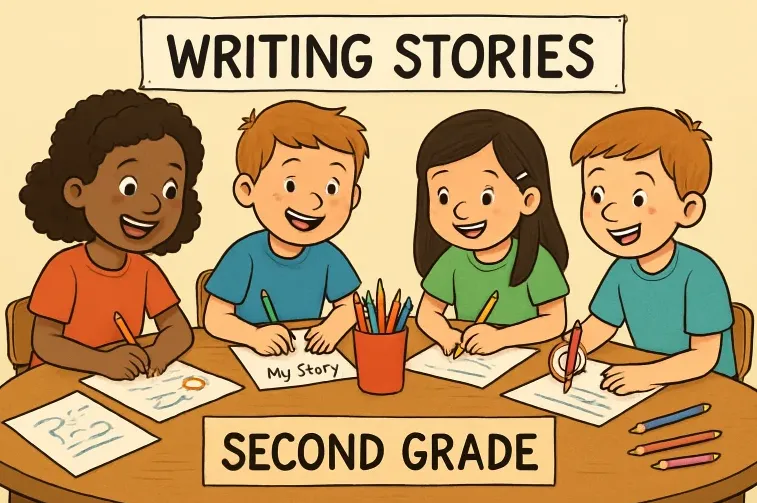Key Takeaways:
- Creative writing enhances second graders’ literacy and cognitive skills.
- Incorporating diverse activities like storytelling and poetry fosters engagement.
- Utilizing resources such as writing prompts and worksheets supports skill development.
Introduction
Fostering creative writing skills in second graders is a powerful way to support early literacy development while encouraging expressive thinking. Young learners are eager to share their unique ideas and explore new communication methods at this crucial stage. Introducing creative writing through engaging activities bolsters foundational skills and motivates students to find joy in the writing process. Teachers and parents can enhance lessons by integrating a variety of tools, including 2nd grade writing worksheets that are designed to spark imagination and help students structure their stories.
Emphasizing creativity in writing enables students to grow both academically and emotionally. When children can invent stories, describe vivid scenes, and express their feelings, they develop confidence alongside critical thinking abilities. This approach benefits their academic performance and builds communication and problem-solving skills they’ll use throughout life.
Educators can engage even reluctant writers by combining structured guidance with open-ended activities. A successful creative writing program ensures that every child, regardless of skill level, can participate, contribute, and discover the excitement of storytelling.
As educators seek new ways to capture students’ interest, integrating interactive resources and real-world connections can help make writing relatable. Teachers can create a multi-sensory environment that reaches various learners by bringing together technology, collaborative projects, and visual prompts.
The Importance of Creative Writing in Second Grade
Creative writing is a special part of the second-grade curriculum because it bridges early literacy foundations and more advanced communication skills. During this period, children rapidly expand their vocabulary and understanding of narrative structure. When second graders engage in creative writing, they learn to organize their ideas, experiment with word choice, and practice grammar in meaningful contexts.
Additionally, writing creatively nurtures empathy and emotional intelligence. As students step into the shoes of different characters or imagine alternate realities, they gain perspective and learn to articulate their feelings. This aspect of the writing process fosters a more profound sense of community and belonging within the classroom.
A well-rounded writing program also connects to other academic areas. For example, when students describe a process in science class or recount a historical event, they apply the same storytelling tools developed through creative writing exercises. This cross-disciplinary benefit is why many experts and organizations, including the Scholastic Parents portal, advocate for strong creative writing integration at all grade levels.
Effective Creative Writing Activities
Providing varied activities helps keep writing sessions fresh, fun, and inviting for second graders. Here are several proven methods:
- Story Starters: Use playful prompts to ignite creativity. Examples include “Imagine you woke up with wings. Where would you go?” or “You discover a door to another world in your backyard—what happens next?” These imaginative openers allow students to craft unique tales while practicing sequential thinking and descriptive writing.
- Picture Prompts: Visual cues are powerful motivators for young learners. Provide students with pictures of whimsical places, interesting people, or mysterious objects, and ask them to write a short story based on what they see. Images help anchor their ideas and enable even hesitant writers to get started.
- Collaborative Storytelling: Group activities, such as “round robin” stories where each student adds a sentence, encourage teamwork, listening skills, and on-the-spot creativity. This type of collaboration makes writing an inclusive, lively classroom event.
- Poetry Exercises: Introducing simple forms of poetry, like haikus or acrostics, can help second graders explore rhythm, language, and structure in a manageable way. Poetry gives children a framework for expressing big emotions in just a few lines.
For additional inspiration, educators can explore creative activity ideas from established resources like Edutopia, which offers insight into evidence-based classroom strategies.
Utilizing Writing Prompts and Worksheets
Writing prompts and structured worksheets are valuable for guiding young writers as they learn to organize their thoughts. These resources introduce sentence starters, graphic organizers, and checklists that scaffold the writing process, making it less intimidating. Students can transition from short phrases to complete stories and reports by offering targeted support, prompts, and worksheets.
Worksheets can also be adapted to suit classroom themes and current events, bringing relevance to assignments. Additionally, pre-made resources save teachers time in lesson planning without sacrificing student engagement. Examples and printable materials explicitly designed for second grade can be found through dedicated educational portals and publishers.
Incorporating Technology in Creative Writing
Digital storytelling has become an engaging way to promote literacy in today’s classrooms. Many kid-friendly platforms and apps allow children to write, illustrate, and publish their own stories online. These digital tools often include interactive elements—such as animation and audio narration—that can spark creativity and motivate reluctant writers to participate more fully.
Technology provides new outlets for creativity and helps differentiate instruction, ensuring all learners benefit. With classroom tablets or computers, students can work individually or in groups to record stories, collaborate on poems, and share their finished works with family members at home.
Assessing and Encouraging Progress
Constructive feedback is essential for student growth and motivation. When teachers review second graders’ writing with a positive, strengths-based approach, young writers are likelier to take risks and persist through challenges. Highlighting improvements and offering specific praise (e.g., “Your use of describing words brings your story to life”) empowers students to build on their abilities.
Class displays of student work, publishing anthologies, and scheduling share-out sessions provide authentic audiences for young writers, encouraging pride and a sense of accomplishment. Ongoing assessment—through formal rubrics and informal observation—ensures teachers can tailor support to each child’s needs.
Conclusion
Integrating diverse creative writing activities into the second-grade classroom cultivates a lifelong love for writing while supporting essential literacy skills. Educators can design inspiring lessons that meet every learner’s needs with tools like story starters, collaborative projects, worksheet resources, and technology. Teachers can guide students on a rewarding journey as confident and capable writers by encouraging imagination, providing meaningful feedback, and offering high-quality resources.



